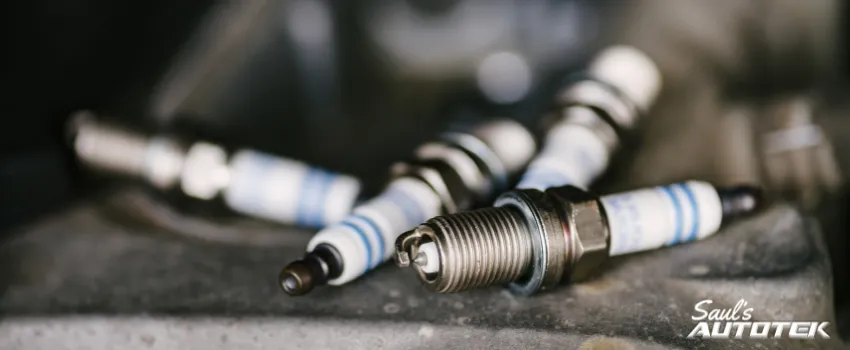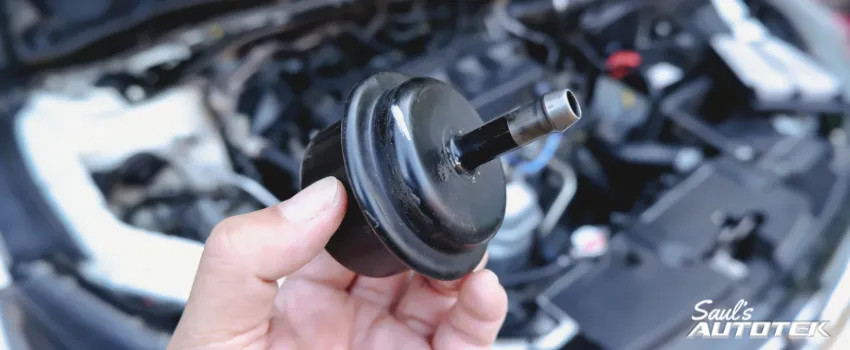Hi there. I’m Saul Reisman, here at Saul’s Autotek, and today, we’re going to talk a little bit about your brake calipers and the way the hydraulic system works in your vehicle.
Ninety-five percent of all motor vehicles on the road use a disc brake with a hydraulic caliper in the front of the vehicle, and 85 percent use the same set up in the rear of the vehicle.
This is one of the most commonly and widely used brake systems that we see. When owners typically either come in or call about their brake concerns, they’re always worried about the brake pad itself, which is the actual friction material designed to burn up. This often is the first place to burn up and get replaced and is the easiest and most cost-effective brake repair service to keep you on the road in Denver.
However, oftentimes in Denver, Colorado, we see vehicles come in where the brake pads themselves are worn unevenly, not square, or even chambered from one side to the other. This is often an indicator of a problem with the hydraulic caliper in the vehicle. It’s something that many repair shops can overlook. Many shops will often sell a brake pad and/or rotor replacement without even inspecting the condition of the pads, simply noting the depth and how much pad life is left in making their recommendation.
At Saul’s Autotek, we want to ensure that if we repair your Denver car or truck braking system, that it works exactly as it did factory, if not better, and that it lasts for the life of the vehicle. We will always check the calipers in your vehicle when it comes in for service as part of our free brake inspection, to make sure that the recommendations we’re making for your vehicle are the proper ones and that the new parts going on your vehicle are going to last and wear in the correct manner.
We are going to start with just a basic single-piston caliper. This is a very basic design. Just like you would use your four fingers and your thumb to squeeze on to something, this caliper’s designed to sit on to a rotating disc in order to squeeze. In the center, we can see the actual caliper piston itself. At this moment, the piston is completely retracted. When a brake pad is installed on the inner and outer portions of it and hydraulic pressure is applied via the lines on the back of it from you pressing on the brake pedal, this piston will extend in order to squeeze the brake.
Now, the way this design works, it should be very reliable, basic, and truly never need servicing. In many vehicles, your calipers will last the life of the vehicle and will never need to be replaced. However, many problems can happen right here in this piston. Over time, this piston, from extending and contracting, can wear unevenly. It can bind and sit askew into the caliper stand. This can lead to uneven brake pad wear.
At the same time, this piston can get firm and stiff inside its housing and not wanna move smoothly. This’ll lead to less wear on the inner pad and more wear on the outer pad. We’ve even seen times where the brake pads get so worn down and so thin that this caliper piston must extend further than its specified range and will actually rupture its seal and lose its fluid – in that case, truly losing brakes and having the pedal go to the floor. This is part of the reason we inspect these on every vehicle for free, ‘cuz we want to ensure your safety at all times.
This caliper design – pretty standard, basic. One single-piston to squeeze against. Nothing on the backside, just the friction of this piece of metal to physically squeeze in and out every time. This is a pretty basic design that’s used on the front end of most trucks and SUVs, up until the late 90s-early 2000s.
The next caliper design that we are going to look at is a dual-piston caliper. Now, while this caliper does have a stand affixed to it from the factor, this caliper also features two independent pistons. The reason for this is by using a smaller bore piston, we’re able to apply Pascal’s principle of hydraulics in a greater aspect to generate more braking capacity, using the same amount of braking fluid. By using the smaller diameter piston, we’re actually increasing our force-per-surface area ratio to get more braking force out of the caliper. Additionally, having two pistons, allows for smoother operation, as there’s more surface area around the perimeter of them for those seals to stay seated and lubricated. This leads to a caliper that wears slower, lasts longer, and truly is a better stopping, performing product.
Additionally, where we see these rubber boots, this caliper slides back and forth as you press the brake pedal so that instead of just squeezing from one side to the other and acting as leverage, this caliper can squeeze from both sides by allowing it to slide and use that frictional stopping power equally. While this isn’t a perfect equal-to-equal force, this allows better distribution to keep the outborn pads wearing at almost the same rate as the inborn pads. This design is known as the Akebono caliper. This is used on everything from Jeep Grand Cherokees to Land Rovers to BMW product and beyond, and this caliper costs about three to four times what a standard single-piston replacement does. This kind of caliper’s used on most trucks/SUVs that we see on a regular basis here at Saul’s Autotek.
We are going to step up our game here in BMW Auto Repair in Denver.
The next caliper we’re gonna look at is a four-piston caliper. Now, this is truly a racing thoroughbred design. We have a few major improvements here that are truly worth noting. First and foremost, we are going to state the obvious: we have four pistons to allow the most equal distribution of braking force possible. By having pistons on either side of the brake pad itself, we have truly 50-50 brake distribution.
Additionally, if we look at the caliper, we can see there’s a seam through the center. This is actually a two-piece brake caliper. When we rotate it over, you can see that there are bolts affixing the one side to the other, and this is to allow fluid to pass through the center of the caliper into the backside and therefore, compress the outborn pistons, the inborn pistons, at the same rate, at the same time.
Now this caliper does not need any rubber boots to slide on, as the caliper itself can apply friction from both directions. One other major important aspect that they’ve upgraded here is instead of the brake pads themselves snapping into the location of the piston to hold them in place, we have two guide pins that are literally just floating pins that’ll stick through the brake pads so that the brake pad can float and not be physically mounted. This allows for the least amount of friction when applying the brakes. It means that when you step onto the brake pedal itself, all four pistons immediately extend. The pads are floating and immediately create friction and you get one of the best stopping systems on the market.
The four-piston caliper is common on higher-end sports vehicles, like the Lexus sedan front calipers or even in the case of this BMW X5 M Sport model we’re working on today. These all utilize the four-piston caliper. This is a major, major performance upgrade and at the same time, is a definitely more expensive caliper than your factor replacements on most vehicles. This caliper’s probably only used in about 10 to 15 percent of applications. However, some manufacturers take your safety very seriously and put these incredibly well-performing brake systems on even their most basic vehicles. One of those manufacturers is Toyota, who puts this design on all of their RAV4s, Four Runners, Tacomas, Tundras, to make sure you’re safe.
One of the last designs we’re gonna look at today is a rear caliper, and this is a very special caliper for a couple of different reasons. First off, it is a single-piston caliper, but we notice that the piston board is not hollow. It is tapered and has two marks on it. These are just marks like you would use for a flathead or Phillips screwdriver. They’re used to retract the caliper. Instead of this piston extending and compressing in a straight line, this piston actually rotates like a screw, as it goes forward and back, and there are a few different reasons for this. While this doesn’t create the most friction, and only has a single-piston caliper, this allows it to be used in the rear of the vehicle where braking capacity is not nearly as significant. It allows the use of a parking brake through a mechanical system, and here’s where things get tricky.
The idea of a parking brake is to use mechanical leverage instead of hydraulic leverage. Sitting in your vehicle holding the brake pedal the whole time is not good for your caliper’s hydraulic fluids. It’s not good for the seals and it’ll eventually wear them out. This is a very impressive piece of technology because it’s a hydraulic piston caliper. It allows the use of a hydraulic caliper in order to close itself, but at the same time, has a spring lever on it that uses spring motion to drive this center screw through the same piston bore. Meaning the same piston can move from either hydraulic pressure or mechanical leverage.
So, in the case of this Volkswagen Audi caliper, when you are to apply your parking brake and pull that lever up, instead of applying hydraulic pressure through the center, you’re applying mechanical pressure. While this does work well and does hold the vehicle, as an integrative design, it saves significant weight over a counterpart of having a standalone mechanical brake. This is not a great design. It doesn’t last long. The screw drive in the center gets stripped out and worn out. They often do not retract properly, and because this parking brake is attached to it, they can be very difficult to service. Some of the locations of their mounting spots in the vehicles have made it a significant labor problem to be able to access these compared to other motor vehicles.
So, while Volkswagen Audi has created a wonderful piece of technology by making this a one-piece integrated design, this is probably the most common replacement caliper that we see here at Saul’s Autotek. If you have a Volkswagen Audi product and your rear calipers haven’t been serviced, please let us check them for free, just to make sure that they’re doing what they should and that everything’s operating properly.
We’ve seen far too many issues with these calipers, leading to them seizing, leaking fluid, bursting, rupturing – all kinds of problems. We want to make sure that doesn’t happen to you. So, we want to take one of the most prevalent ones that we see here at our facility and give you a little bit better knowledge about how to see this yourself. If, when you apply the brakes in the Volkswagen or Audi vehicle, you feel the vehicle pull to one side or the other, or you feel a chatter or uneven braking, 99 percent of the time, the problem’s coming from one of these rear calipers.
Here at Saul’s Autotek in Denver, we stock these on our shelves because they’re such a commonality replacement. If you have a problem with your brakes, please give us a call at (303) 919-7769. We’ll be happy to help.
We can be reached seven days a week at (303) 919-7769, and we would be happy to give you a FREE brake inspection on your car or truck in Denver and Greenwood Village Colorado.
Schedule Your FREE diagnostic Subaru Outback Auto Repair Upkeep and Repair Appointment
Check out Our Reviews On Yelp! And Leave A Great One For Us!
Join Our Conversation on Facebook
Explore Our Exceptional Denver Auto Repair Services
- Brake Repair Service
- Suspension Repair
- Steering Repair
- Engine Repair
- Automotive Air Conditioning and Heating Repair





